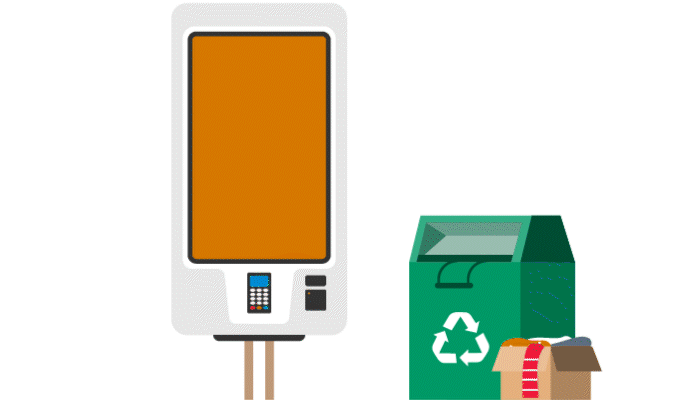Returns & Waste Management

Extra, Extra Retail Waste from Returns: Read All About It!
Imagine this: It’s the year 2050. A customer adds a shirt from your e-commerce platform to their cart. They opted for their usual size, medium, but did not read the product description, which suggests sizing up due to the product SKU running particularly small. Before the shirt ships, they receive an automated email saying, “Based on our data, a size larger might fit you better. Want to swap? Simply reply ‘yes’ to this email.” The chances of a return are significantly reduced thanks to machine learning (ML) algorithms that caught the potential sizing disparity before the item shipped. This is good news because it means less waste, fewer returns, and a positive impact on the bottom line of your business. While this type of system may not currently be deployed, mass use may not be as far away as you think.
Largely due to the rise of e-commerce, retail returns have proliferated globally which has vastly increased waste and continues to pose significant environmental and economic consequences. In the U.S. alone, retail generates more than $2 billion in waste each year, with an estimated 40% ending up in landfills, according to Link Retail. As waste compounds, retailers are feeling mounting pressure from both their customers and stakeholders who are increasingly concerned about environment degradation and calling for more sustainable practices — to the extent they are reconsidering their purchases and investments  altogether.
altogether.
Beyond the initial point of sale and reducing returns to the extent possible, retailers should also think about the resale market and how they can encourage consumers to recycle and reuse unwanted products throughout the product life cycle. Now and into the future, minimizing waste won’t just be about mitigating the risk of a return but finding new purpose for products by, in part, instituting or engaging in resale programs and shifting consumer mindsets about what qualifies as “waste.”
To future proof your retail business, it is critical to adopt a variety of waste reduction practices to avoid preventable returns, minimize the environmental and economic impact of unavoidable ones, and – all the while – get creative about resale strategies to help lower carbon footprints.
Listen to BDO’s 60-second Retail podcast episode, “ESG in Retail: Ethical Consumerism,” to understand why retailers are adopting environmentally friendly practices.
The Magic Eight Ball Says...ESG Can’t be Ignored
Retailers are gradually adopting more environmentally friendly business practices to conserve resources and ensure alignment with stakeholder and regulator demands. As climate risks intensify - from exacerbating extreme weather to droughts and flooding to resource depletion issues such as deforestation - retailers are expected to see environmental risks become increasingly material to business continuity.
Beyond grappling with the carbon footprint of business decisions, retailers are now juggling aligning their practices with their customers’ values. To do so, building trust will be paramount. “Retailers’ inability to keep up with Gen Z and millennial demands for commitments to social responsibility” is one key area where trust is waning, according to a recent Gallup poll. To close the trust gap, retailers must clearly define their purpose and organizational core values beyond digital enhancement of customer experience, the poll suggests.
However, defining ESG commitments and values will require a hard look at waste generation and management. Most retailers discard or liquidate 40% of returns, which amounts to nearly five billion pounds of waste annually, according to Supply & Demand Chain Executive. Beyond this, the National Retail Federation estimates that for every $1 billion in sales, the average retailer sees $165 million in merchandise returns.
To address some of these concerns, many retailers have introduced return fees in their return policies. There has also been increased appetite for the resale market, allowing customers to resell their unused or unwanted items at a discounted cost, according to Insider Intelligence. Retailers can partner with secondary resale providers – a trend known as “re-commerce” – to avoid products simply ending up in landfills. To develop this type of strategy takes two parts: First, retailers will need to formalize an educational initiative so that their customers know this is an option. Second, retailers should codify circulatory programs that support recycling or reselling – this is where working with secondhand sellers comes in. In doing so, retailers are extending the life of a product through having a second owner procure and use the product and, thereby, are reducing waste.
Currently, the retail industry is spending a significant amount of focus and energy on recycling and circulatory programs. But will that be enough 20 years from now? That remains to be seen, as customer demands for environmentally friendly practices are only a piece of the puzzle. In the near future, regulatory standards and sustainability compliance will also dictate how retailers should adapt.
Amid expanding ESG regulations, maintaining compliance and satisfying stakeholders complicates retailers’ business decisions. The Sustainability Accounting Standards Board (SASB) is one such body that is looking to standardize ESG accounting and disclosure practices. SASB aims to standardize and “identify the sustainability-related issues most relevant to investor decision-making in 77 industries”. As such, SASB has developed industry-specific sustainability classifications, including those for the retail and consumer goods sector. With these guidelines, SASB aims to facilitate more consistent and comparable “financially material sustainability factors” – sustainability benchmarks – across peer groups. SASB, which had previously merged with the Value Reporting Foundation, merged into the IFRS Foundation on August 1, 2022. Accordingly, the SASB guidance has been integrated more broadly into the guidance from the International Sustainability Standards Board (ISSB), which delivers “a global baseline of sustainability disclosures” and governs the sustainability standards development process.
The relationship between ISSB and SASB underscores the urgency for retailers to educate themselves on sustainability. ISSB has been working to expand on and improve SASB’s standards so that companies have a clear understanding of how to apply these standards to the new IFRS Sustainability Disclosure Standards. In June 2023, ISSB launched two global sustainability reporting standards: IFRS 1 and IFRS 2. These two new standards set forth rules for climate-related disclosures and go into effect in January 2024. In short, ISSB posits that industry-specific disclosures are not just important – but mandated – to properly “identify sustainability-related risks, opportunities, and appropriate metrics,” according to SASB’s blog. ISSB views the SASB guidance as an appropriate place for many companies to start in preparation for compliance with the new IFRS standards.
Retailers will need to assess and improve related procedures to comply with these standards and forthcoming disclosure regulations. Learning to reduce retail waste is an imperative element. To mitigate waste and the financial impact of merchandise returns, retailers will need to innovate. Faster, more energy-efficient distribution channels and predictive inventory management systems are just two ways to advance these objectives and address customer and stakeholder demands.
Learn more about how key stakeholders are thinking about ESG risk and opportunity in our insight, “The Stakeholder Value Mandate.”
Machine Learning and Minimizing Returns – A Perfect Match
E-commerce returns typically occur when customers receive wrong or defective product(s) or feel uncertain about the quality of their purchase, according to Insider Intelligence. So, how do retailers course correct? There are a range of technologies that retailers should consider implementing in their supply chains and logistics to minimize the environmental impact of unavoidable returns, as well as prevent returns to the best of their ability.
From analyzing consumer data to better understanding and predicting customer sizes and preferences, machine learning (ML) is a key tool retailers can use to minimize the likelihood of returns that aren’t caused by an order error and ultimately lower their carbon footprint. There are various use cases for ML too, even when a return is necessary. For unavoidable returns, ML can be used to inform and effectively mitigate the transportation costs of a product being shipped back so the value of the return isn’t negated by shipping expenses, according to Forbes. ML tech can also identify and help decrease fraudulent returns.
Another potential – and simpler — tactic for retailers to future proof is rolling out more robust consumer education initiatives on the environmental impact of their returns. Picture how a retailer might take an incentivized educational approach in the future. Some might consider creating customer pledge initiatives.
For example, customers can sign a pledge when creating an account with a retailer to return no more than five items annually out of the products they buy. The customers who uphold this pledge, minimize returns and, ultimately, participate in a more sustainable retail experience could receive store credit upon proof of upholding this commitment. This program could also look like a customer completing a return and being required to purchase a carbon credit, a credit of monetary value used to fund various climate change initiatives and offset the environmental impact of a return.
 Educating consumers on circulatory programs and resale initiatives will also be key. In doing so, retailers are naturally reducing the risk of waste or potential returns because consumers would be inclined to recycle or sell unwanted products within the secondhand market.
Educating consumers on circulatory programs and resale initiatives will also be key. In doing so, retailers are naturally reducing the risk of waste or potential returns because consumers would be inclined to recycle or sell unwanted products within the secondhand market.
Adopting these types of solutions and approaches enables retailers to better address the root causes of returns and take action to prevent them, or to encourage customers to at least consider the ramifications of excessive returns on the environment. In doing so, retailers can improve profitability while conserving energy, time, and resources.
In order to fully future proof the business, many retailers will find they can benefit from the help of an experienced third-party advisor.
How BDO Helps Retailers Reduce Their Carbon Footprint
Over time, regulators, investors, customers, and other stakeholders will expect retailers to reduce their carbon footprint. As a first step, it is critical to understand your Greenhouse Gas Inventory. This is a complex assessment which includes a myriad of components, including, among other things, determining the embedded carbon of the products you sell, the carbon associated with the transport of your goods and, ultimately, the carbon resulting from the waste related to your products, whether through returns or at end-of-life. Once you know your footprint, you can begin the process of setting emissions reduction targets and designing and implementing an emissions mitigation strategy. Your stakeholders have expectations that these activities will revolve around a science-based approach such as that associated with the Science Based Targets initiative.
Equally important is understanding the evolving risk landscape — from supply chain disruptions and emerging ESG regulations to market conditions and the impact they have on both customers and stakeholders. A deep understanding of these elements sets the foundation for a resilient business model today and 20 years from now.
At BDO, we’re committed to helping you develop, implement, and improve your ESG program, effectively reduce your carbon footprint, and build trust with your stakeholders.
Whether you’re starting at the beginning with a sustainability self-assessment, adapting your ESG reporting to comply with new regulations or standards, developing a net-zero roadmap, or designing a long-range climate mitigation plan, BDO’s ESG professionals offer a suite of Sustainability & ESG Services and Solutions.
Returns are a part of retail, but contributing to environmental waste doesn’t have to be.
Ready to go green?
BDO’s Retail and Consumer Products professionals are readily available to offer deep industry expertise around your waste reduction strategy so you can gain a competitive edge today and in the future.